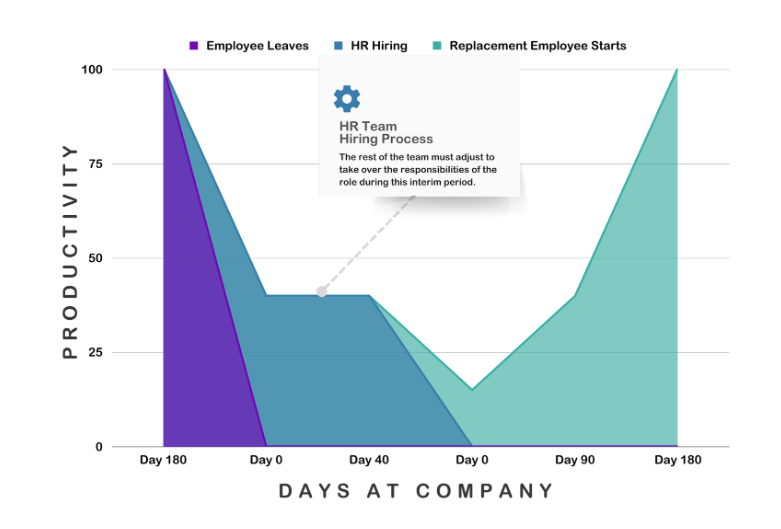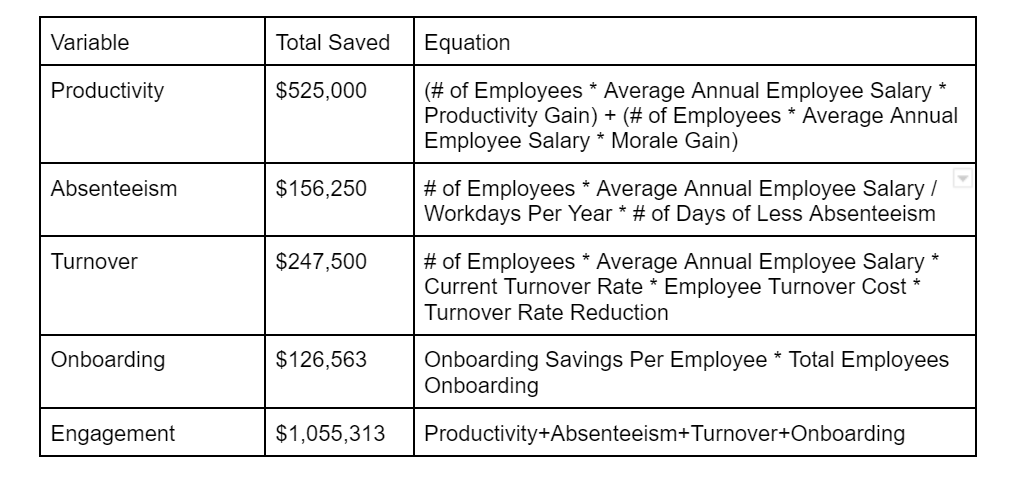How Employee Engagement Affects Your Bottom Line
You might feel like employee engagement is a bit of a buzzword that gets thrown around too much in the workplace. But if there is...
by Rachel McQuigge - October 24th, 2022
You might feel like employee engagement is a bit of a buzzword that gets thrown around too much in the workplace. But if there is one thing that has become obvious over the last few years, employee engagement is an essential part of overall business strategy.
Employees who are more engaged with their jobs and companies tend to be more satisfied and productive than those who aren't—and research has shown that this translates directly into increased revenue for many companies.
Low engagement costs the global economy an estimated US$7.8 trillion and accounts for 11% of GDP globally, reports Gallup. Their analysis shows a strong link between engagement and performance outcomes, such as retention, productivity, and profitability.
In fact, for a company of 100, improving engagement saves an estimated $1m+ annually.
Let's look at how employee engagement affects your bottom line and why it's crucial for employers to focus on this metric:
How do I calculate the ROI of employee engagement?
We consider four variables: productivity, absenteeism, turnover, and onboarding.
Gallup found that business units with engaged workers have 23% higher profits than those with miserable workers. These teams with engaged workers also saw lower absenteeism, attrition, and higher customer loyalty. As Gallup puts it, "Well-being at work isn't at odds with anyone's agenda."
The four components have a specific formula:
How are Employee Engagement Savings Calculated?
To calculate these savings, we multiplied each variable by its corresponding cost and added them together.
A company of 100 employees, with a turnover rate of 20% and an average salary of $75k, saves $1,055,313 annually by increasing employee engagement.
How do we get to that million-dollar figure?
Employee Engagement Increases Productivity
Employee engagement increases productivity at work, but do you know how much a disengaged employee costs your company? Employees who are not engaged cost their company 18% of their annual salary. Meaning that a disengaged employee making $75k costs their company $13,500 with lower productivity.
Note: How we feel about our jobs directly impacts our performance. When employees feel engaged with their work and interested in what they're doing, they naturally become more motivated and, therefore, more productive at work.
Morale is the job satisfaction, attitude, and outlook employees share at your business. It directly influences team productivity and engagement. Highly engaged teams are 14% more productive than those that are disengaged.
Note: Morale plays a significant role in how a team interacts with each other. Many aspects can affect team morale, but teammates' low productivity, high absenteeism, and turnover primarily affect it.
Here is how we calculate the savings an engaged team will provide with productivity:
The productivity savings multiply the number of employees (100), average yearly salary ($75k), and the productivity gain (5%) plus the number of employees (100), average annual salary ($75k), and the morale gain (2%).
Increased productivity results in annual savings of $525,000!
Employee Engagement Reduces Absenteeism
The definition of absenteeism is employee sick leave days for non-medical purposes. These non-medical purposes are the additional days an employee is absent because they would instead not work that day. We estimate that engaged employees use five fewer sick days per year than disengaged employees.
Absenteeism costs roughly $3,600 annually for each hourly worker and $2,660 for each salaried employee. These costs come from wages and administrative expenses and do not include productivity loss. It also does not have the impact on other employees burdened with filling in.
Note: There are various reasons disengaged workers might take more sick days than engaged ones. They may not feel motivated to come to work or be productive, leading to more sick days than coworkers. They may also feel isolated from their team or manager, and missing out on work just allows them to avoid this environment (even though it could cost them their jobs).
Here is how we calculate the savings lower absenteeism will provide:
The absenteeism savings are multiplied by the number of employees (100) and average annual salary ($75k) divided by the number of workdays per year (240) times the number of days with less absenteeism (5). Reduced absenteeism results in annual savings of $156,250!
Employee Engagement Reduces Turnover
Employee Turnover is the rate at which employees leave a workforce and get replaced. Some turnover is expected to occur naturally; however, the concern is that employees leave prematurely due to better job opportunities elsewhere, conflict within the workplace, disengagement, and more. Gallup compared the top-quartile business units with the bottom-quartile for employee engagement and found that highly engaged business units had 18% less turnover in high-turnover organizations. Low-turnover organizations had 43% lower turnover.
Turnover costs up to 200% of an employee's annual salary, and it takes up to three months before their replacement is fully productive again. For an employee who makes $75k annually, they cost up to $150k to replace.
Note: This estimated replacement cost comes from wages, administrative duties, recruiting, hiring, training, and the loss of productivity the new hire will experience while onboarding.

Notes on how this turnover affects your productivity:
When employees leave an organization, they often take their knowledge and experience. This loss of knowledge leads to a loss of productivity as the organization tries to rebuild its workforce.
When employees leave, the organization must find and train a replacement. Replacing an employee is expensive and time-consuming.
It takes an average of 90 days to onboard an employee fully. Research has shown that new hires work at 15% of their total productivity during this time.
Here is how we calculate the savings in reducing turnover due to disengagement:
Turnover savings multiplies by the current turnover rate of 20%, turnover cost (38%), and expected turnover reduction (33%). Reduction in turnover results in an annual saving of $247,500.
Employee Engagement Reduces Onboarding Costs
Onboarding is an expensive aspect of the employee life cycle. Outside of recruitment and training costs, it takes an average of 90 days before employees function at total productivity. If engagement efforts increase retention, onboarding will be a negligible company cost.
According to SHRM's Human Capital Benchmarking Report, the average cost per hire across organizations and industries is $4,125. The average cost to onboard a new employee is approximately $3,000.
This cost per new employee onboarded means a company of 100 with a turnover rate of 20% and an average growth rate of 10% will onboard 20 employees, totaling $60k in sole costs for onboarding. There are many more costs associated with the process.
How we calculate the total amount saved with onboarding by engaging employees is as follows:
Finally, onboarding multiplies the onboarding savings per employee ($4k+) and the total onboarding (30). An engaged team saves $126,563 annually on onboarding.
Onboarding savings per employee is calculated by dividing the average annual salary ($75k) by the workdays per year (240) multiplied by the days of onboarding (90) and increment of value (15%).
Total employees onboarding is calculated by taking the new positions per year (10) multiplied by the replacement employees per year (20).
New positions per year are found by multiplying the average growth rate of companies (10%) by the number of employees (100).
Replacement employees per year multiples the current turnover rate (20%) with the number of employees (100).

Why do leading companies trust eNPS with reducing turnover?
"What gets measured, gets managed." - Peter Drucker
eNPS is a leading indicator of employee engagement and helps you measure the impact of your engagement strategy.
Why? Because it captures what matters to people in their work lives: whether they love coming to work each day and how much they feel engaged by their leaders, managers, and coworkers, not just whether they like the company's culture or mission statement (though those things matter too).
The best way to get employees feeling proud—and engaged—is by taking care of them at every level within your organization: from attracting top talent to developing talent once they're on board.
Conclusion
Engaged employees are a crucial part of your organization's business system. When your employees are engaged, they work more effectively and productively, improving productivity and profitability. They are also more likely to stick around, reducing turnover and absenteeism, such as sick days. In short, a well-engaged team reduces costs while increasing revenue. That's good business sense.
Recommended Posts
How to Improve Employee Experience with eNPS [+template]
Blog Articles
22 Employee Engagement Ideas That Remote Workers Love
Blog Articles
35+ Employee Engagement Survey Questions You Must Ask
Blog Articles
Search...
Product
GoCo
Resources
Articles
eBooks
Webinars
Customer Stories



